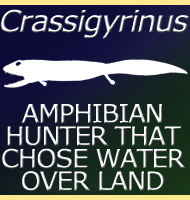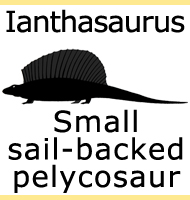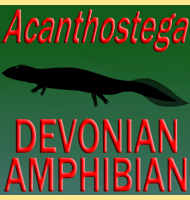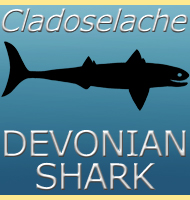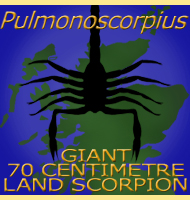


Spathicephalus
Name:
Spathicephalus.
Phonetic: Spa-fe-sef-ah-lus.
Named By: Watson - 1928.
Classification: Chordata, Elpistostegalia,
Stegocephalia, Stegocephalia, Spathicephalidae.
Species: S. mirus (type),
S. marsdeni, S. pereger.
Diet: Piscivore.
Size: Skull 22 centimetres long.
Known locations: Canada. Scotland.
Time period: Carboniferous.
Fossil representation: Partial remains of several
individuals.
Spathicephalus
is a genus of early tetrapod that lived during the Carboniferous.
Whereas most creatures of its kind had rounded snouts,
Spathicephalus is notable for having a roughly
square shaped snout
when seen from above. The teeth of Spathicephalus
are very small and
densely packed together, leading to speculation that Spathicephalus
may have fed upon aquatic invertebrates, filtering them from the
water through their teeth. Analysis of the hyoid process of
Spathicephalus suggests that Spathicephalus
may have also been a
suction feeder, creating sudden low pressure within its mouth to draw
smaller aquatic organisms into its mouth.
Further reading
- A rhachitomous
amphibian, Spathicephalus, from the
Mississippian of Nova Scotia.
- Breviora. 157: 1–9. - D. Baird - 1962.
- The
cranial morphology and relationships of the aberrant Carboniferous
amphibian Spathicephalus mirus Watson. -
Zoological Journal of the
Linnean Society. 122: 187. - E. H. Beaumont & T.
R. Smithson - 1998.
- A new Mississippian tetrapod from
Fife, Scotland, and its environmental context". Papers in
Palaeontology. 3 (4): 547–557. - Timothy R. Smithson,
Michael A. E. Browne, Sarah J Davies, John E. A.
Marshall, David Millward, Stig A. Walsh & Jennifer A.
Clack 2017.
----------------------------------------------------------------------------
Random favourites
 |
 |
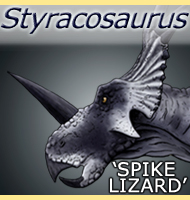 |
 |
